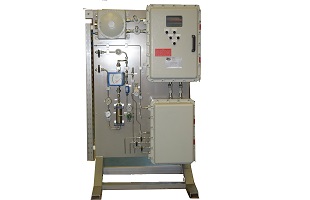MOD-4100S Solution
Crude oil, a cornerstone of the global economy, is indispensable across industries, especially for producing chemicals and materials. Despite its value, crude oil presents significant challenges when contaminants, such as salts, are present. These salts, primarily chlorides of sodium, calcium, and magnesium, are dissolved in the water emulsified within crude oil. If not properly managed, the presence of salts can lead to costly operational issues, including corrosion, clogging, and reduced efficiency in refinery processes. Monitoring and controlling the salt content in crude oil, therefore, becomes essential to safeguarding refinery operations and maximizing the market value of the crude oil.
Impact of Salt on Refinery Operations
The presence of excessive salts in crude oil poses multiple threats throughout the refining process. Salt can precipitate, causing mechanical blockages in furnace tubes, condensers, and pipelines. Even more critically, when salts undergo hydrolysis, they produce hydrogen chloride, which accelerates corrosion in refinery equipment. This not only increases maintenance costs but also results in unexpected downtime due to equipment failure. Furthermore, excessive salt content raises the ash levels in refinery residues, which can damage catalysts used in refining units. These issues underline the importance of accurately measuring and controlling salt concentrations before crude oil enters the refinery.
One of the most widely recognized standards for assessing salt content in crude oil is ASTM D3230-19, which measures chloride levels using a conductivity-based method. According to this standard, if the salt content exceeds 20 PTB (pounds of salt per thousand barrels), desalting is recommended before processing. By adhering to these guidelines, refineries can prevent the long-term consequences of corrosion and scaling, ensuring smoother operations and prolonging the lifespan of critical refinery equipment.
The impact of corrosion plays a major impact on the refinery economics, causing heavy losses to the crude distillation units and downstream process units, such as the FCC or thermal crackers. Corroding of the walls of the processing unit is not the sole problem. A lot of damage is caused by reaction products of H2S and HCl with iron surfaces, such as iron chlorides and iron sulfides, which plug and foul pipelines. This reduces the efficiency of heat transfer in heat exchangers, affects the flow between different distillation plates in the CDU, and increases corrosion in the overhead system.
Replacement and repairing of corroded and damaged parts, including related human resources, are heavy, but not major maintenance expenses. It should be well understood, that most of the financial losses are assigned to the shutdown time for repairing when the refinery unit does not produce.
H2S, Mercaptanes, and Sulphur are important key components in the corrosion of the crude distillation units, but their impact can be controlled by blending sulfur-rich crude oils with sweet crude oil, and by diluting the sulfur concentration, or by chemical treatments.
Major corrosion influencers of the CDU, are chloride salts, which are dissolved in the water-oil emulsion of crude oils. Mainly three different chloride salts are available in crude oils, Sodium Chloride (NaCl), Calcium chloride (CaCl2), and Magnesium Chloride (MgCl2). Whereas Sodium Chloride is quite stable under the refining temperatures, magnesium chloride and calcium chloride react easily with water (humidity) when heated, while liberating hydrochloric acid (gas) and precipitating alkali hydroxides.
Hydrogen chloride that enters the CDU, is absorbed by condensed water that is formed when the temperature decreases below the Dew Point. Especially the acidic condensate will corrode the walls of the CDU, which will further result in the blocking and plugging of the CDU, plates, and pipelines. Salt that enters the vacuum tower also decomposes and contaminates the HVGO which serves as feedstock for the FCC, which aside from corrosion also shortens the lifetime of the catalyst.
In case salt remains in bottom residues, it will partially find its way to the FCC, but also to other cracking processes such as the visbreakers. The presence of sodium chloride, but merely the presence of unreacted calcium and magnesium chlorides will attack not only the processing unit itself but also pipelines and heat exchangers. As a result of corrosion and resulting fouling and plugging of pipelines and heat exchangers, more energy will be required to pump the petroleum products through the pipelines, and due to a reduced heat transfer capacity of the heat exchangers, more heating will be required to keep these thermal processes running.
Real-Time Salt Measurement: The MOD-4100S Solution
To address the critical need for continuous salt monitoring in crude oil, Modcon Systems has developed the MOD-4100S on-line analyzer. This advanced system offers real-time analysis of salt content at multiple stages of the crude oil supply chain, from extraction at the wellhead to refining processes. The MOD-4100S employs an electrometric method that correlates with ASTM D3230, using conductivity measurements to provide accurate and immediate salt concentration data.
The MOD-4100S analyzer is designed for continuous operation and is adaptable to various points in the crude oil processing chain, including transportation, storage, blending, and desalting. By offering continuous monitoring, the MOD-4100S enables operators to make real-time adjustments to refinery processes, optimizing desalter efficiency and reducing operational costs associated with water, chemical, and energy usage. The system also helps mitigate the risks of corrosion, fouling, and pipeline blockages, ultimately ensuring a more efficient and cost-effective refinery process.
Key Features of the MOD-4100S
The MOD-4100S on-line salt-in-crude analyzer provides several significant benefits that enhance its value in the oil refining industry:
- Comprehensive Monitoring: The system provides continuous data on salt content from the oil well to the refinery, including during transportation, storage, and blending operations.
- Desalter Optimization: The MOD-4100S helps optimize the desalter process by providing real-time data on salt concentrations before and after desalting, enabling more efficient use of water and chemicals.
- Corrosion and Fouling Prevention: By reducing salt concentrations in crude oil, the MOD-4100S minimizes the risk of corrosion, fouling, and plugging in pipelines and refinery equipment.
- No Shelter Requirement: Designed for field conditions, the MOD-4100S does not require an analyzer shelter, making it a practical solution for various installation environments.
- ATEX Approval: The system is approved for use in hazardous areas (Zone 1), ensuring safe operation in challenging environments.
- Integrated Control System: The analyzer is equipped with a control system that allows seamless integration into a customer’s DCS, providing operators with instant access to analytical data.
The MOD-4100S features an integrated sampling handling and conditioning system that ensures crude oil samples are brought to the proper physical condition for analysis. This includes filtration and separation from solid particles, enabling precise conductivity measurements. The system’s continuous sampling capability from pipelines, tanks, or process vessels allows for uninterrupted monitoring and analysis, ensuring that salt content is accurately measured at critical points in the crude oil supply chain.
The new design of the MOD 4100 analyzer system is based on a “Modular Package concept”. It is inspected and tested by the factory, and ready for immediate installation on-site. The following crude oil critical parameters can be measured on-line and correlated to ASTM:
- Salt Concentration (D3230)
- Distillation (D2892, D86)
- SARA (IP-143 and D893-69)
- Emulsion stability (F3045, D4007 and D3707)
- Hydrogen Sulfide content (D5705)
- RVP (D6377 and D323)
- Viscosity (D445 and D2501)
- Water Content (D4928 and D4006)
- Sulfur content (D2622 and D4294)
- Density (D4928 and D1250)
Additionally, the system is designed for efficient data transfer, allowing real-time results to be sent directly to the control room. This capability supports prompt decision-making, ensuring that any issues related to salt content are addressed before they impact refinery operations.
Conclusion
As the global demand for crude oil remains high, and as refinery operations become more sophisticated, the need for precise and continuous monitoring of contaminants like salt is more critical than ever. The MOD-4100S on-line salt-in-crude analyzer from Modcon Systems provides an innovative solution to this challenge, offering real-time, reliable data on salt content throughout the crude oil processing chain. By integrating this technology into refinery operations, companies can significantly reduce operational risks, optimize process efficiency, and ultimately safeguard their investments in infrastructure and equipment.




